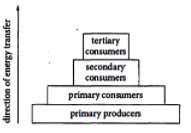Question
The energy pyramid below shows four trophic levels in an ecosystem and the direction of energy transfer between those levels.

On average, 10% of the net energy of one trophic level is transferred to the next trophic level in an ecosystem. Based on the energy pyramid, if primary producers have 5,000 joules (J) of energy, approximately how much of this energy, in calories, is transferred to the secondary consumers in this ecosystem? (1 calorie= 4.18 J)
- 11.96
- 20.90
- 119.6
- 209.0
The correct answer is: 11.96
1 cal = 4.18 Joules
1 Joule = 
Primary products have 5000 joules = 5000 ×0.24 calories = 1200 calories
Primary consumers have 10% of 1200= 120
Secondary consumers have 10% of 120 = 12
Energy flow direction within an ecosystem
1. An ecosystem's energy flow is always unidirectional.
2. It is said to be unidirectional because energy is lost in heat when moving from one trophic level to the next to maintain an organism's homeostasis.
3. As a result, each successive trophic level receives less energy than the previous trophic level.
4. Some energy is lost as heat when an organism moves from one trophic level to the next to maintain homeostasis.
5. As a result, each successive trophic level receives less energy than the previous trophic level.
6. Because the sun is the only energy source for all ecosystems on Earth, the energy flow in the food chain is unidirectional.
7. The energy captured by autotrophs does not return to the sun.
8. As a result, energy flows through various trophic levels in a food chain.
9. Energy comes from the sun and is consumed by producers in most natural ecosystems.
10. It is then passed down through the trophic levels as food.
11. As a result, energy flows from the prey to the predator rather than the other way around.





